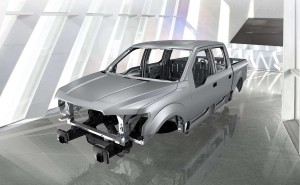The aluminum Ford F-150 SuperCrew received a five-star overall crash safety from the NHTSA — one star higher than the 2014 model made of steel, Ford announced Thursday.
The regular-cab F-150 had not yet been evaluated by the National Highway Traffic Safety Administration.
The board of the Insurance Institute of Highway Safety, which also releases high-profile crash-test ratings, was expected to also get a preview of that organization’s findings today, IIHS tweeted.
Ford said the SuperCrew was the safest F-150 reported to date. (The NHTSA cautions, “Because of the more stringent tests, 2011-newer model ratings are not comparable to 1990–2010 vehicles” — but Ford’s still probably right.)
“A bad rating for the new model would have been horrendous for Ford, which invested millions of dollars to retool two plants to make the truck with an aluminum body,” the Detroit Free Press said in an article Thursday. “And it would have given ammunition to the skeptics who still aren’t convinced aluminum can perform as well as steel.”
That might have been the last F-150 hurdle for Ford to overcome in terms of selling the truck to a mainstream audience. Some research indicates that individual safety features might resonate more with customers than the overall safety rating, so it might be moot. But it definitely matters to an insurer setting rates, and what insurers will conclude once they get a year of data is the million-dollar-question.
Plus, it still gives a car salesman ammunition to convince a customer who thinks of aluminum as the flimsy metal in Coke cans and aluminum foil.
The F-150 received five stars in every crash test conducted by the NHTSA except in rollovers, in which it received four. The more high-strength-steel-intensive Chevrolet Silverado 1500 and GMC Sierra 1500 received the same reviews — so the steel industry isn’t out for the count by any means. No other 2015 model year truck has received an overall five-star rating yet this year, but the NHTSA doesn’t appear to be done rating them yet.
In any case, the engineering that Ford said made the F-150 safer in a crash is of interest to collision repairers who will fix it afterward.
Steel, aluminum and glue
Ford attributes the rating to items like two-stage airbags as well as the design of the high-strength steel frame and aluminum body that collision repairers have been expensively preparing to fix.
Those metals’ ability to protect passengers were considered by Ford engineers and in its simulations.
“The team had to invent new ways to manage crash energy, because advanced materials like high-strength steel behave differently,” Ford truck safety manager Matt Niesluchowski said in a statement. “We found that changing certain shapes led to a weight reduction, while also improving crash performance.”
The truck has an extra crossmember and a “patented 12-corner front crush horn” that dissapates more frontal-crash energy and ensures the “frame buckles predictably to keep those forces away from occupants in the cabin,” according to Ford.
The aluminum cab has hydroformed roof rails (the rails were shaped by liquid pressure instead of stamping or welding) creating a cage around the doors and extruded rocker rails and roof bows.
And also of note: Glue made a safer truck than welds, Ford says.
“How various parts of the truck were joined also yielded safety improvements,” Ford said. “In many cases, welding was not the most effective way to join parts, so the team developed and patented methods to connect parts using high-strength adhesives. This resulted in structural strength equal to or greater than traditional welds.”
More information:
“2015 Ford F-150 SuperCrew Earns 5-Star Top Government Crash Ratings Thanks to 31 New Safety-Related Innovations”
Ford, April 16, 2015
“5 stars: Aluminum Ford F-150 gets top score for safety”
Detroit Free Press, April 16, 2015

